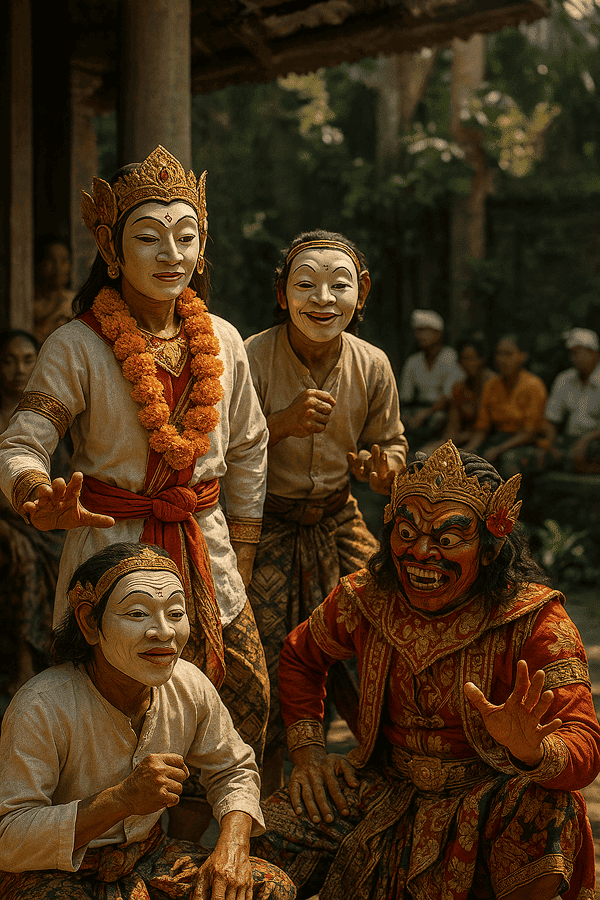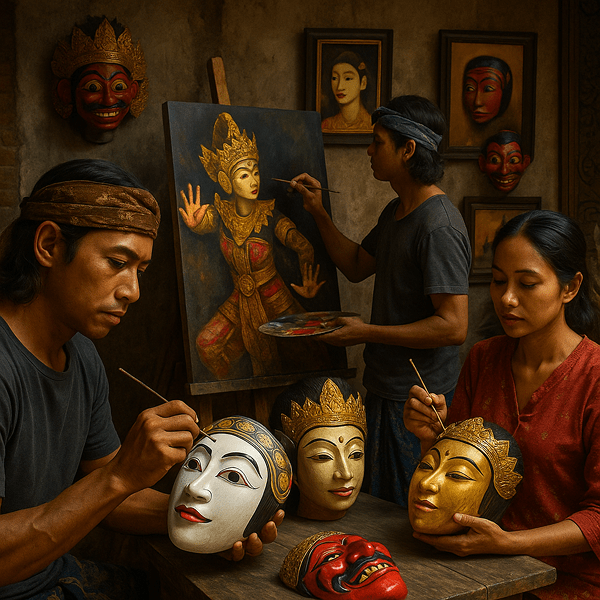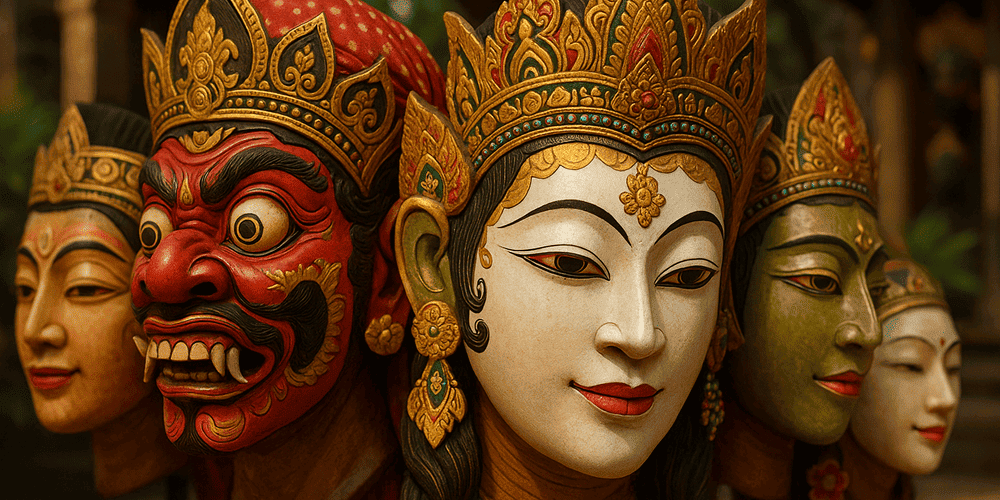Topeng Masks are one of the most iconic and expressive forms of Indonesian visual and performing arts. Instantly recognizable for their vivid colors, intricate carvings, and dramatic facial expressions, Topeng Masks are typically made from lightweight wood and painted in bold reds, whites, greens, and golds. The features may range from serene and beautiful to grotesque or comical, each representing a specific character or archetype in traditional dance and drama. Belonging primarily to the cultural landscapes of Java and Bali, Topeng Masks have played an essential role in Indonesian ceremonies, religious rituals, and theatrical performances for centuries. Their origins can be traced back to at least the 10th century, and they continue to captivate audiences both locally and globally.
Historical Origins of Topeng Masks
The history of Topeng Masks is closely intertwined with the development of Javanese and Balinese performing arts. The word “topeng,” meaning “mask” in Indonesian and Javanese, is derived from the old Javanese term “tapuk” or “tapel,” which signifies disguise or cover. The earliest references to Topeng performances appear in inscriptions from East Java dating to the 9th and 10th centuries, suggesting a strong link to royal courts and Hindu-Buddhist rituals. Over time, Topeng Masks evolved as a means to tell epic stories from the Ramayana, Mahabharata, and local legends, as well as to connect communities with ancestral spirits and deities. The arrival of Islam in Java brought new influences, blending older Hindu-Buddhist traditions with Islamic aesthetics and storytelling. Throughout the centuries, the design and function of Topeng Masks have continued to change, reflecting shifting religious, social, and political landscapes. Archaeological finds, ancient temple reliefs, and historical texts attest to the enduring importance of masks in Indonesian culture.
Cultural Significance and Symbolism of Topeng Masks
In Indonesian culture, Topeng Masks are far more than theatrical props; they are imbued with deep symbolic and spiritual meaning. Each mask represents a distinct character — ranging from noble kings and wise priests to tricksters, clowns, demons, and mythical animals. The act of donning a mask is considered a transformative ritual, allowing the wearer to embody the spirit or essence of the character. Many Topeng performances are deeply connected to religious ceremonies, such as temple festivals, harvest rituals, and rites of passage. Mythological tales, such as the adventures of Panji or the battles of the Mahabharata, are brought to life through the expressive power of the mask. In some communities, masks are believed to hold protective or healing properties and are treated with reverence and ritual offerings. The use of Topeng Masks also serves important social functions — reinforcing community values, transmitting moral lessons, and celebrating local identity.

Materials and Craft Techniques of Topeng Masks
The traditional crafting of Topeng Masks is a highly skilled art form, passed down through generations of master carvers (seniman topeng). The most commonly used materials are lightweight woods such as pule, crocodile wood, or jackfruit, selected for their fine grain and workability. The process begins with the careful selection and spiritual cleansing of the wood, followed by rough shaping with chisels and knives. Artisans then carve the detailed facial features, hollow out the interior for comfort, and sand the surface smooth. Once the basic form is complete, the mask is painted with natural pigments or commercial paints, and decorated with gold leaf, shells, beads, or fabric. Each region and workshop has its own unique techniques and stylistic preferences — for example, Balinese masks often feature elaborate crowns and vibrant colors, while Javanese masks may be more restrained and elegant. Color symbolism plays a crucial role: red denotes bravery or anger, white purity, black wisdom or the supernatural, and gold divinity. The decorative elements are carefully chosen to enhance the mask’s symbolic power and stage presence.
Functions and Uses of Topeng Masks
Topeng Masks serve a wide range of ritual, ceremonial, and theatrical functions. In religious contexts, they are worn by dancers and priests during temple festivals, exorcisms, and ancestor worship ceremonies to invoke spiritual forces and bless the community. In the realm of theater, Topeng is a popular form of dance-drama in both Java and Bali, featuring solo and ensemble performances that bring to life epic tales, historical narratives, and local folklore. Masks are also central to public festivals, royal processions, and community celebrations, where they entertain, educate, and unite audiences. Over time, the use of Topeng Masks has evolved, with modern interpretations appearing in contemporary theater, art installations, and cultural tourism. Today, they are also used in educational programs, museum exhibitions, and international performances, ensuring the tradition remains dynamic and relevant.
Regional Variations of Topeng Masks
Indonesia’s diverse cultures have given rise to a wide variety of Topeng mask traditions. In Java, Topeng Cirebon is famous for its refined style and distinct characters, such as Panji, Rumyang, and Kelana. Balinese Topeng, on the other hand, is known for its vibrant colors, intricate decorations, and dramatic, exaggerated features. In Bali, the Topeng Pajegan (solo masked dance) and Topeng Panca (multi-character dance) are especially popular, each with its own repertoire and performance conventions. Other regions, such as Madura, Lombok, and Kalimantan, have developed their own unique mask styles, often reflecting local legends and religious practices. While there are similarities with mask traditions in neighboring countries — such as Thailand’s Khon or Japan’s Noh — Indonesian Topeng Masks are distinguished by their complex storytelling, emotional range, and strong ties to community ritual.
Famous Examples and Collections of Topeng Masks
Some of the most celebrated Topeng Masks are preserved in museums and collections throughout Indonesia and around the world. The National Museum of Indonesia (Jakarta), Museum Puri Lukisan (Bali), and Museum Sonobudoyo (Yogyakarta) all house significant collections, including historic and contemporary masks. Notable examples include the elaborately decorated masks of the Cirebon court, the sacred Sidakarya mask of Bali, and ancient wooden masks discovered in temple complexes and royal palaces. Many private collectors and international museums, such as the British Museum and the Musée du Quai Branly (Paris), also feature Indonesian Topeng Masks in their collections. Online resources like toddmasks.com offer virtual galleries and expert analysis, making these treasures accessible to a global audience.
Influence of Topeng Masks on Art and Culture
The influence of Topeng Masks on Indonesian art and culture is far-reaching. Their expressive forms and mythic themes have inspired painters, sculptors, and contemporary performers across the country. Topeng motifs appear in literature, dance, film, and music, where they symbolize transformation, hidden identity, and the interplay between the sacred and the everyday. Modern designers and artists have adapted mask imagery for fashion, graphic design, and theatrical innovation, blending tradition with fresh creativity. The continued presence of Topeng Masks in cultural festivals, educational programs, and the international art world helps preserve and transmit Indonesia’s unique heritage to new generations.

Contemporary Status and Preservation of Topeng Mask Traditions
Today, the tradition of Topeng Mask making and performance is alive and evolving, thanks to dedicated artisans, cultural organizations, and master dancers. Many villages in Java and Bali are home to family workshops where mask carving is taught and practiced as a living art. Government and private initiatives support the preservation of Topeng through festivals, grants, and cultural tourism. Educational programs and masterclasses — often featured on toddmasks.com — ensure that young people learn about the history, symbolism, and techniques of Topeng. Innovations abound, with artists experimenting with new materials and digital media, while respecting the spiritual roots of the tradition. International collaborations and museum exhibitions have also contributed to the global appreciation and sustainability of Topeng Mask culture.
Collecting and Acquiring Topeng Masks
The market for Topeng Masks is vibrant and diverse, ranging from affordable contemporary masks to valuable antiques with historical provenance. Authentic Topeng Masks can be acquired from artisan studios, traditional markets, galleries, and reputable online platforms. Prices are influenced by factors such as age, craftsmanship, rarity, and provenance. Collectors should always prioritize ethical sourcing, support local artists, and verify the authenticity of masks, especially when purchasing older or rare pieces. Toddmasks.com provides expert advice on collecting, authentication, and the cultural context of Topeng Masks. Ethical considerations are paramount — respecting the sacred origins of masks and supporting the communities that sustain this unique heritage.
